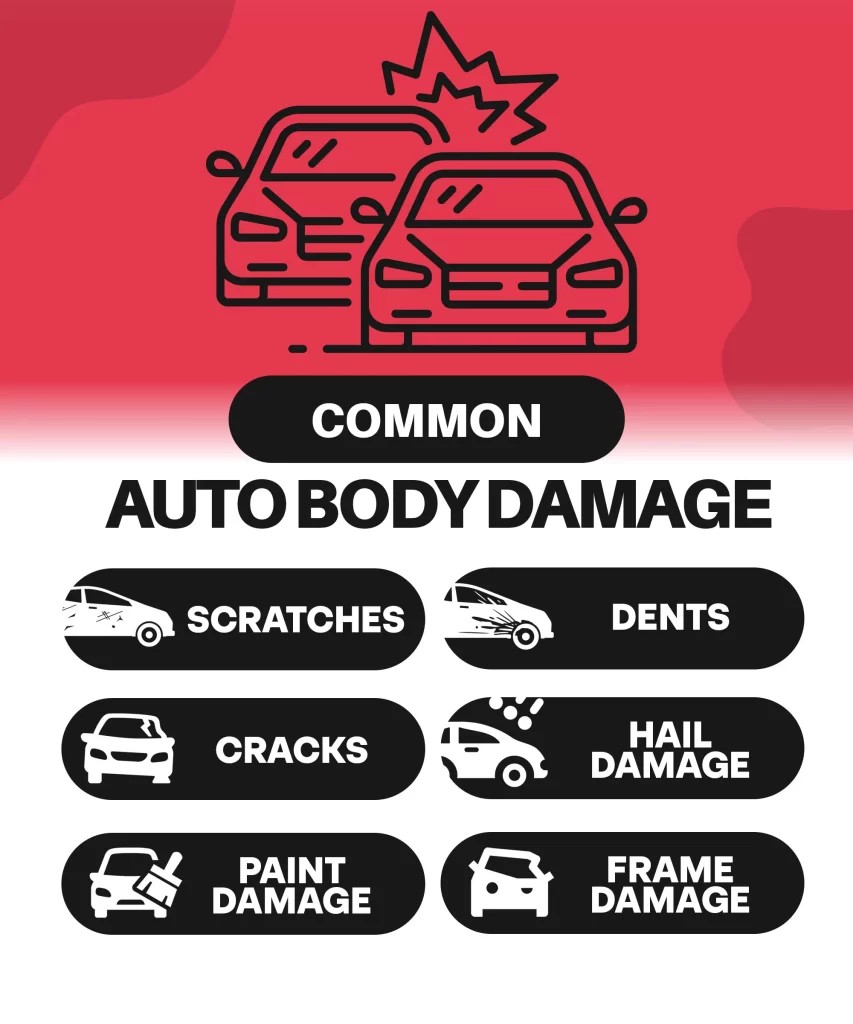Minor auto body damage is an unfortunate but common part of car ownership. From parking lot scrapes to rogue shopping carts, your vehicle’s exterior can easily pick up dings, dents, and scratches. While major damage requires professional attention, many minor auto body repairs can be tackled at home, saving you time and money. This guide will walk you through the essential steps and techniques for repairing minor auto body damage, helping you restore your car’s appearance and protect it from further issues.
Understanding Common Minor Auto Body Damage
Before diving into repair techniques, it’s important to identify the type of damage you’re dealing with. Minor auto body damage typically falls into these categories:
1. Scratches
These are superficial marks on the car’s clear coat or paint. They can range from light surface scratches that you can barely feel to deeper scratches that penetrate the color coat.
2. Minor Dents
These are shallow depressions in the metal panels, often caused by small impacts. They might be barely noticeable dings or slightly larger dents without paint damage.
3. Paint Chips
These occur when small pieces of paint are chipped away, often exposing the metal underneath. They’re common on the hood, fenders, and bumpers, especially from road debris.
4. Bumper Scuffs
These are abrasions and paint transfer on plastic bumpers, usually resulting from minor bumps or scrapes. They often appear as scuffed or discolored areas on the bumper surface.
5. Hail Damage (Minor)
In cases of light hail, the damage might be limited to numerous very small, shallow dents across horizontal panels like the hood and roof.
DIY Techniques for Minor Auto Body Repair
For many types of minor damage, you can achieve excellent results with DIY techniques. Here are some effective methods:
1. Washing and Cleaning the Damaged Area
The first step in any repair is to thoroughly clean the affected area. Use car wash soap and water to remove dirt, grime, and wax. This allows you to clearly assess the damage and ensures proper adhesion of repair products.
2. Scratch Repair Techniques
- For very light scratches (clear coat scratches): A scratch remover compound is often sufficient. Apply a small amount to a microfiber cloth and gently rub in a circular motion. These compounds work by lightly polishing the clear coat to level out minor scratches.
- For slightly deeper scratches (reaching the color coat): A touch-up paint pen or bottle matching your car’s color code is necessary. Clean the scratch, apply primer if needed (for deeper scratches exposing metal), and then carefully apply thin coats of touch-up paint. Allow each coat to dry completely before applying the next. Follow with clear coat if your touch-up paint doesn’t include it, and finally, use a rubbing compound for blending.
3. Minor Dent Repair with Paintless Dent Removal (PDR) Principles
- For small, shallow dents without creases: While professional PDR requires specialized tools, you can try DIY methods for very minor dents. Gentle pushing from behind the panel (if accessible) or using a suction cup dent puller can sometimes pop out small dents. Hair dryers or heat guns (used carefully and at a safe distance) can also help make the metal more pliable for pushing dents out.
- For slightly larger, shallow dents: DIY dent repair kits with glue tabs and pullers can be effective for dents that are a bit larger but still shallow and without sharp creases. Follow the kit instructions carefully.
4. Bumper Scuff Repair
- Cleaning and buffing: For minor scuffs, cleaning with a plastic cleaner and using a rubbing compound might be enough to remove or significantly reduce the appearance of the scuff.
- Touch-up paint for deeper scuffs: If the scuff has removed paint or is deep, use touch-up paint formulated for plastic bumpers. Clean the area, apply adhesion promoter for plastic, and then apply thin coats of touch-up paint, blending it carefully.
When to Seek Professional Auto Body Repair
While DIY repairs are suitable for many minor issues, certain types of damage require professional expertise. Consider professional repair for:
- Major dents and creases: Dents with sharp creases, large dents, or dents in critical structural areas are best left to professionals.
- Damage affecting vehicle safety: Damage near sensors, lights, or affecting structural components should be professionally assessed and repaired.
- Extensive paint damage: Large areas of peeling, fading, or damaged paint often require professional refinishing for a seamless match.
- Frame damage: Any suspected frame damage, even from a minor accident, needs professional inspection and repair.
- If you are uncomfortable with DIY: If you lack confidence or are unsure about any step, it’s always better to consult a professional auto body shop.
Key Takeaway
Repairing minor auto body damage yourself is a practical way to maintain your car’s appearance and value. By understanding the types of minor damage and the appropriate DIY techniques, you can effectively address scratches, small dents, and bumper scuffs. However, it’s crucial to recognize the limitations of DIY and seek professional help when dealing with more complex or significant damage. Addressing even minor damage promptly can prevent further issues like rust and maintain your vehicle in good condition. For any damage beyond your DIY comfort level, consulting with a reputable auto body repair shop is always the best course of action to ensure quality and safety.


